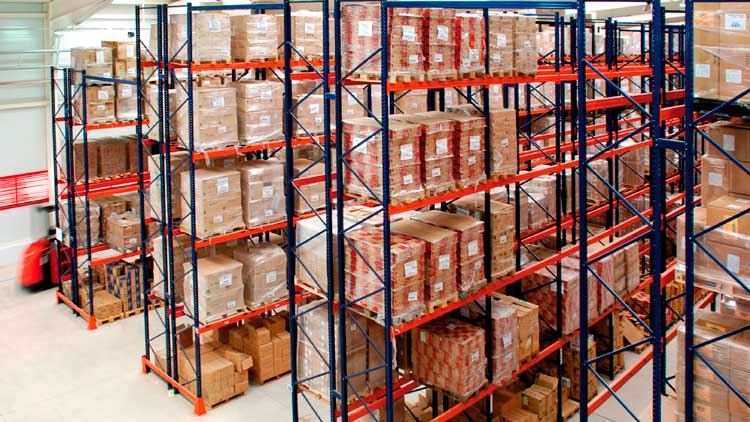In the world of warehouse storage and material handling, choosing the right racking system can significantly impact efficiency and organization. Among the most commonly used types are bolted racks and boltless racks.
While both provide durable storage solutions, they differ in design, assembly, and application. Understanding these differences helps businesses select the best racking system for their specific storage needs.

What Are Boltless Racks?
Boltless racks, often called rivet racks or clip shelving, use a unique interlocking design that allows components to snap or slide into place without bolts or nuts. This design makes them faster and easier to assemble compared to bolted systems.
Boltless racks are usually used for light to medium-duty storage needs, where flexibility and quick installation are important.
Key Features of Boltless Racks
❈ Tool-free assembly: Components lock together with rivets or clips, reducing setup time.
❈ Adjustable shelves: Shelf heights can be easily changed to accommodate different product sizes.
❈ Versatile design: Ideal for retail storage, office supplies, or parts organization.
Applications of Boltless Racks
❈ Retail stockrooms
❈ Home garages and workshops
❈ Light industrial storage areas
❈ Distribution centers with frequent layout changes
What Are Bolted Racks?
Bolted racks are traditional shelving systems that use nuts, bolts, and other hardware components to secure beams and uprights together. They are designed to provide strong, rigid storage for heavy loads.
These racks are commonly made of steel and can be adjusted or reconfigured, though it requires tools and time to assemble or modify. They are suitable for applications where storage setups remain stable for long periods.
Key Features of Bolted Racks
❈ High load capacity: Bolted racks are ideal for storing heavy goods such as metal components, tools, and large inventory boxes.
❈ Durable structure: The bolted connections enhance the rack’s strength and stability, making them suitable for industrial environments.
❈ Cost-effective for permanent use: Once assembled, bolted racks can last for many years with minimal maintenance.
Applications of Bolted Racks
❈ Manufacturing facilities
❈ Industrial warehouses
❈ Automotive parts storage
❈ Tool and equipment rooms
The Differences Between Bolted Racks and Boltless Racks
While both rack types serve similar purposes, their design and usability differ in several key aspects.
1. Assembly and Installation
Bolted racks require nuts, bolts, and wrenches for installation, which can take longer.
Boltless racks can be assembled quickly without tools, saving labor time.
2. Flexibility
Bolted racks are less flexible because adjustments need disassembly.
Boltless racks allow for easy shelf height adjustments and quick layout reconfiguration.
3. Load Capacity
Bolted racks typically support heavier loads due to their reinforced bolted joints.
Boltless racks are better suited for medium to light loads.
4. Maintenance and Reconfiguration
Bolted systems are harder to move once installed but offer long-term stability.
Boltless systems are easier to relocate or expand when storage needs change.
5. Cost Considerations
Bolted racks are usually more economical for large, permanent installations.
Boltless racks may have a slightly higher initial cost but save on installation time and labor.
Choosing the Right Rack for Your Warehouse
Selecting between bolted and boltless racks depends on your operational needs, product weight, and warehouse layout.
Choose Bolted Racks If:
❈ You need high load capacity and long-term durability.
❈ Your storage layout remains consistent over time.
❈ You require robust shelves for heavy industrial goods.
Choose Boltless Racks If:
❈ You prefer quick assembly and easy adjustment.
❈ Your inventory changes frequently.
❈ You need flexibility for light or medium-weight storage.
FAQ: Bolted vs. Boltless Racks
Q1: Which type of rack is stronger — bolted or boltless?
A1: Bolted racks are generally stronger because the connections are secured with nuts and bolts, providing greater stability for heavy loads.
Q2: Are boltless racks durable enough for warehouse use?
A2: Yes, boltless racks are durable for light to medium-duty applications, making them suitable for most warehouse, retail, or office environments.
Q3: Can boltless racks be reconfigured easily?
A3: Yes, boltless racks are designed for quick reconfiguration. You can adjust shelf levels or relocate the rack without tools.
Q4: Are bolted racks more affordable than boltless racks?
A4: Bolted racks often have lower initial costs but require more labor to assemble. Boltless racks save on assembly time, which can reduce overall setup costs.
Q5: How do I decide between bolted and boltless racks for my storage needs?
A5: Consider the weight of your products, frequency of layout changes, and installation time. Bolted racks are best for permanent heavy-duty storage, while boltless racks offer flexibility and convenience.
Conclusion
Understanding what is the difference between bolted and boltless racks helps businesses choose the most efficient storage solution. Both systems provide reliable support, but their assembly, flexibility, and capacity differ. For heavy-duty, permanent setups, bolted racks are a strong choice. For adjustable, quick-to-assemble storage, boltless racks offer the flexibility many warehouses need.
Looking for the right racking system for your warehouse?
📞 Contact us today to get a customized storage solution designed for your business needs.




